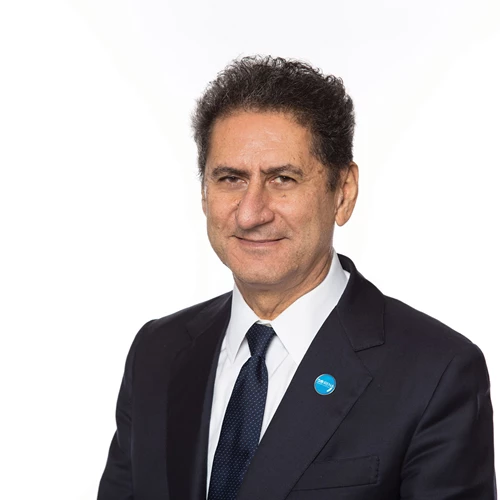Forging the path towards a sustainable future
As we stand at a pivotal moment in our collective journey towards a sustainable future, I find myself reflecting on both the challenges and immense opportunities that lie ahead for the global energy transition.
At the helm of the International Renewable Energy Agency (IRENA), I am acutely aware of the urgency of the situation, yet I am also profoundly optimistic about what we can achieve if we act decisively.
A new energy paradigm
The world is transitioning towards an energy system that will be primarily driven by renewables, a future where hydrogen—especially green hydrogen—plays a crucial complementary role, alongside the sustainable use of biomass. We are on the right path; the direction is clear. However, if there's one area where we continue to fall short, it is in the speed and scale of this transformation. Last year, we set a new global record with 273 gigawatts of renewable energy installed—a remarkable 30% increase from the previous year. Yet, this is not nearly enough.
According to the International Panel on Climate Change (IPCC), to achieve the necessary reductions in CO2 emissions by 2030, we need to install over 1,000 gigawatts of renewables annually from now until the end of the decade.
This is a call for a dramatic acceleration. We must change how we produce and consume energy. Our infrastructure must evolve, embracing decentralisation, and our grids must become interconnected, flexible, and resilient. The current market, designed for a centralised energy system, does not yet adequately support this transition. This must change if we are to succeed.

"The world is transitioning towards an energy system that will be primarily driven by renewables, a future where hydrogen—especially green hydrogen—plays a crucial complementary role, alongside the sustainable use of biomass. We are on the right path; the direction is clear. However, if there's one area where we continue to fall short, it is in the speed and scale of this transformation."
Africa at the forefront of the energy transition
In this journey towards a decarbonised future, Africa stands out as both a challenge and an incredible opportunity. Without proper infrastructure, attracting private capital to support renewable projects on the continent will be difficult. Energy that is generated cannot simply be plugged into a grid that doesn’t exist or isn’t sufficiently developed. That's why we're working closely with multilateral financial institutions, urging them to prioritise Africa's infrastructure development.
IRENA, in partnership with Kenya’s President William Ruto, has launched the Accelerated Renewable Energy Partnership for Africa (APRA). This initiative, supported by countries like Germany, Denmark, the US, and the UAE, provides a comprehensive support system—360 degrees—from planning through to project implementation. We are helping African countries shape their Nationally Determined Contributions (NDCs), which will be crucial in the lead-up to COP30, while also working to facilitate funding for renewable projects. This is about more than just energy. It’s about creating wealth, fostering industrial development, and, ultimately, laying the foundation for Africa's sustainable future.
Breaking the barriers to 1.5°C
However, the obstacles we face globally are substantial. Chief among them is infrastructure. Without the capacity to distribute electricity effectively, it will be impossible to scale decentralised renewable energy systems. The lack of infrastructure also discourages private investments, particularly in regions like Africa, where the need is most critical.
The second barrier is the outdated energy market. Today, we continue to subsidise fossil fuels—a practice that sustains the old energy paradigm. The market rules we have in place were designed for a centralised energy system, not the decentralised one that renewable energy requires. We must rethink and redesign the market to support renewables, ensuring that this new energy system can thrive.
Finally, the third challenge is institutional capacity. Managing a more complex, decentralised energy system will require stronger institutions, better policies, and a workforce equipped with the skills necessary for the green transition. This is why capacity building is so critical—not just at the technical level but within institutions that will govern and manage this new system.
"In this journey towards a decarbonised future, Africa stands out as both a challenge and an incredible opportunity. Without proper infrastructure, attracting private capital to support renewable projects on the continent will be difficult."
Moving forward: COP29 and beyond
In the months leading up to COP29 and beyond, we must ensure that the pace of transformation accelerates. We need to align our policies, institutions, and investments with the realities of a decentralised, renewable-driven energy system.
Time is of the essence, and if we can create the right conditions, this transition will not only be swift but also inclusive, providing clean, affordable energy for all.
As the Director-General of IRENA, I am deeply committed to this vision. Together, we have the power to reshape our energy future, ensuring that we limit global warming to 1.5°C and create a world that is sustainable, equitable, and prosperous for generations to come.
Energy Connects includes information by a variety of sources, such as contributing experts, external journalists and comments from attendees of our events, which may contain personal opinion of others. All opinions expressed are solely the views of the author(s) and do not necessarily reflect the opinions of Energy Connects, dmg events, its parent company DMGT or any affiliates of the same.






